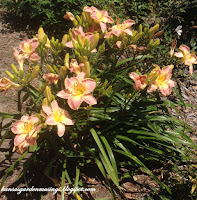 |
| 'Forbidden Fantasy' |
Daylily season is just moving beyond its peak here at Garden Musings, so I thought I would provide some colorful entertainment in the form of some of my favorite daylilies. There will be, of necessity, less of my usual colorful commentary, however, as this is a pretty long post full of photos. I'll start off with the daylily that I think is the most spectacular my garden: 'Forbidden Fantasy'. Go ahead, let go of the ruffled rim and slide down that purple surface into the bright yellow and green center. Titillating, isn't it?
 |
| 'Alabama Jubilee' |
All daylily affections are dependent, however, upon your personal color palette and taste. Mrs. ProfessorRoush, for instance, likes the oranges, the more gaudy the better, and she has expressed her appreciation for 'Alabama Jubilee, a somewhat tasteless addition from last year.
 |
| 'Amethyst Art' |
A long time stalwart in my back garden beds, however, is 'Amethyst Art', which has unfailingly provided me with loads of flowers for the past decade. I think the shade of pink-purple here matches the center perfectly.
 |
| 'Bubblegum Delicious' 2015 |
I purchased 'Bubblegum Delicious' about 3 or 4 years ago and it has developed into the most prolific clump of flowers. Look at that display coming on in the photo at left! I'm disappointed, however, that this year the colors seem muted compared to last year.
 |
| 'Bubblegum Delicious' 2014 |
 |
| 'Butterflies in Flight' |
 |
| 'Slender Lady' |
Sometimes, in some years, my tastes change and I enjoy the yellows again, either in subtle, tasteful forms such as 'Butterflies in Flight', or, when the spiders catch my eye, as in 'Slender Lady'. The latter is quite the image of a bulemic model, isn't she?
 |
| 'Laura Harwood' |
 |
| 'Southern Wind' |
'Southern Wind' (left) and 'Laura Harwood' (right) are two new daylilies for me this year, two of the few times that I've selected a daylily by seeing the actual bloom instead of just the plant tag. 'Laura Harwood' has an enormous bloom, larger than my outstretched hand. And everyone knows that anything over a handful is wasted.
 |
| 'Margaret Mitchell' |
'Margaret Mitchell' is a wonderful symphony of subtle color; here she blooms hidden deep inside a lilac. She's a canvas of pink, purple, white, and yellow, all designed to lead those pollinators right to her luscious core. I need to make a mental note to move her out into the sunshine this Fall.
One of my favorites this year, and always, is this bright red daylily that I have evidently split into several clumps and spread near my Griffith Buck rose bed. Here it blooms alongside yarrow 'Pomegranate'. I think this is most likely 'Seductor', since it bloomed with the 'Seductor' that I have identified in another spot, but another possibility is 'Old Barnyard Rooster'. Anybody want to weigh in?
 |
| 'Seductor'??? |
I hope you enjoyed the show. I certainly have enjoyed them this year. And to all the daylily aficionados who have recognized that these are not even close to the newest and fanciest daylilies out there, you just keep sneering and keep dividing your daylilies for club-support sales. I'm happy to take any of the newer ones off your hands at $3.00 a start.
















